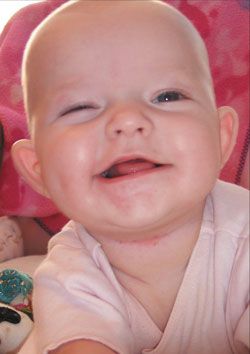5-Month-Old Girl With Left Facial Droop of Sudden Onset
A 5-month-old girl presented with left facial droop of sudden onset. The infant had nasal congestion for the past 2 days, but had been eating well. There was no recent history of rash, trauma, medication use, or drug allergies.

THE CASE: A 5-month-old girl presented with left facial droop of sudden onset. The infant had nasal congestion for the past 2 days, but had been eating well. There was no recent history of rash, trauma, medication use, or drug allergies. Her medical history included left clavicular fracture that occurred at birth from a difficult delivery; she also had nasolacrimal duct stenosis.
The patient’s temperature was 37.1°C (98.8°F). The left tympanic membrane was bulging with erythema. There was no discharge from the ear. The right tympanic membrane appeared normal. A left-sided facial paralysis was present; the child was unable to close the left eye completely. The left nasolabial fold was flat and the left corner of the mouth drooped with crying. There were no other remarkable physical findings.
Facial nerve paralysis secondary to otitis media is the correct answer.
DISCUSSION: The diagnosis was acute otitis media with facial nerve involvement. The patient underwent emergent left wide myringotomy and received a 3-day course of intramuscular ceftriaxone followed by oral prednisone for 7 days. Placement of a pressure-equalizing tube was considered.
Cultures of fluid removed during myringotomy revealed 2+ Streptococcus pneumoniae sensitive to ceftriaxone and penicillin G and 1+ coagulase-negative Staphylococcus.
At postoperative follow-up 7 days later, the patient’s facial nerve function had improved but had not stabilized. She was able to blink and close her eyes. Postprocedural drainage had markedly decreased in the ear. She appeared healthy and was afebrile. Oral amoxicillin clavulanate was prescribed. At follow-up 2 weeks later, the patient had regained facial nerve function and was doing well. Six months later, the patient had another episode of facial nerve paralysis secondary to acute otitis media. A tympanostomy tube was placed.
In a recent study, acute otitis media was found to be the most common cause of facial nerve paralysis in children.1 Facial nerve paralysis may also be congenital or it may be caused by trauma, Lyme disease, Ramsay Hunt syndrome, or neoplasm. The pathophysiology is not well understood; paralysis is thought to be secondary to retrograde infection with the facial nerve bony canal or to demyelination of the facial nerve secondary to bacterial toxins.
While experience in such cases is limited, most otolaryngologists or intramuscular) and perform a myringotomy-with or without pressure-equalizing tube placement.2 Cultures of the fluid taken at myringotomy are positive in about half of cases; the most commonly identified organisms (as in this patient’s case) are Gram-positive streptococci (eg, S pneumoniae) and Staphylococcus species.
The use of corticosteroids in the management of facial nerve paralysis secondary to otitis media remains controversial. Some patients recover without such therapy. Systemic or topical corticosteroids are used in an effort to hasten resolution of middle ear exudate and to decrease injury to the facial nerve.3 Patients with facial nerve paralysis also often need local eye care, with artificial tears and lubricants. Facial nerve function usually returns to normal within a month. If no improvement is noted after 7 days of therapy, a CT scan of the temporal bone may be indicated to rule out mastoiditis or other processes.2
Case and photograph courtesy of Tim C. Lee, MD, Jane Auh, MD, and Eugene Kim, MD of Camino Medical Group, Sunnyvale, Calif.
References:
REFERENCES:
1. Evans AK, Licameli G, Brietzke S, et al. Pediatric facial nerve paralysis: patients, management and outcomes. Int J Pediatr Otorhinolaryngol. 2005;69:1521-1528. Epub 2005 June 27.
2. Gaio E, Marioni G, de Filippis C, et al. Facial nerve paralysis secondary to acute otitis media in infants and children. J Paediatr Child Health. 2004;40:483-486.
3. Popovtzer A, Raveh E, Bahar G, et al. Facial palsy associated with acute otitis media. Otolaryngol Head Neck Surg. 2005;132:327-329.
Recognize & Refer: Hemangiomas in pediatrics
July 17th 2019Contemporary Pediatrics sits down exclusively with Sheila Fallon Friedlander, MD, a professor dermatology and pediatrics, to discuss the one key condition for which she believes community pediatricians should be especially aware-hemangiomas.
Dupilumab safe, effective for up to 1 year for atopic dermatitis in infants, preschool children
May 3rd 2024According to new study data presented at the 2024 Pediatric Academic Societies Meeting, dupilumab (dupixent; Sanofi and Regeneron) demonstrated positive safety and efficacy results for up to 1 year in infants and preschool-age children with atopic dermatitis.